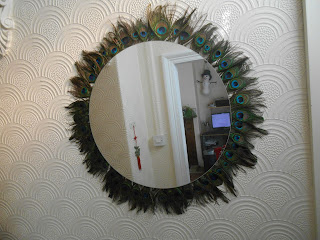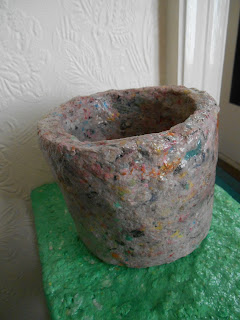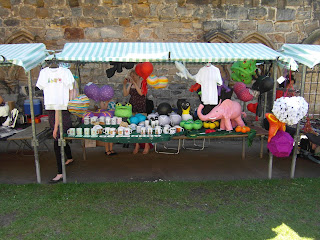It can take a while to get used to how much pva to mix in with your pulp. I go by texture. I squish some into a lump and if its clinging to itself when I pull it apart then it's ready. It needs to stick to itself better than it sticks to your hands, for your own sanity as much as anything. I add more PVA if I want a smoother finish such as when I'm doing a final layer. I'm currently working on making videos of the process and will add a few posts on working with pulp that will provide more information later.
Papier mache furniture, pinatas, origami, collages, decoupage, pulp projects, hand made paper and other crafting ideas
-
These are incredibly simple but effective origami leaves. You will need: 1 square of paper a little time and patience. Fold your square...
-
About 10 years ago I was a skint student and got fed up with having to buy new shoe racks because the kids and their friends kept destroying...
-
There are lots of ways to make a piñata. Traditionally they are made out of clay, nowadays they’re mostly made out of cardboard. I...
Sunday, November 28, 2021
How to make paper pulp or paper clay
Monday, November 1, 2021
How to make a pinata
5) Once it’s all completely dry you can cut a hole for the door with a sharp knife. Cut out three sides of a square or rectangle and fold it outwards. Pull out any balloons, string or masking tape after popping any that haven’t already deflated.
If you have a design that you're not sure of or would like to know how we've made any of the piñatas on the blogs then why not drop us a line and we'll show you how its done!
Saturday, October 30, 2021
Setting up your busines 1: What comes first?
The first thing you need to do is decide what you'll be selling. You can either just choose the things you love and what you're good at or start searching lists of what's popular and trending. Apparently currently this is:
1) face masks (although the market for this seems pretty saturated already)2) Jewellery
4) reusable cloth bags
5) upcycled vintage items and dyed clothing
6) ceramics, especially pots
7) home fragrance
8) knitted and fabric home decor such as rag rugs
9) bath stuff (especially bath bombs)
10) resin crafts
I've chosen to sell the things I have and love making which is basically any paper related products I can set my hand to and nothing which was listed as popular anywhere. This is partly because one of the reasons I'm trying to sell my work is because I'm running out of space in my house. The bonus is that if you enjoy what you're doing and producing things with love the outcome is often much better.
Once you have a product it's time to choose a name. For artwork the ideal is to use your own name, be your own brand. Unless your name is really common like mine. I tried multiple variations but apparently it's so common there was already someone coming up in every google search. whatever you choose needs to be easy to find. Something that isn't difficult to spell and doesn't already come up in searches. I thought about using an old family name but apparently I come from common stock and it didn't feel right somehow using someone elses name.
Choosing a name based on what your selling is great if you have a firm idea of what you will be selling and can think of something that's not already in use. I plan on adapting what I make as I go along and I already have quite a range of things to list and 'random paper stuff' didn't feel quite upmarket enough. In the end I found something that I felt suited me - I can be quite unladylike (allegedly) and I don't think of myself as an artist.
If you get stuck there are random name generators to help spark an idea and I know of at least one fb group of people that are more than happy to help with suggestions. Don't spend too much time getting hung up on a perfect name, you can always change it and rebrand yourself later. Something that amuses you the first time you hear it is likely to be come less amusing with time.
Remember if you're not selling you're marketing. To become and stay successful you need to learn and adapt as you go along. If you aren't getting sales sometimes it's not the product it's something else.
Advertising: getting on the top 5 social media platforms and posting at least once a week. Sometimes it can take time to get noticed, especially if you're not lucky enough to have money or contacts to help advertise your work. The last time I did this I managed to get an exhibition, mentions in magazines newspapers and even had my work on tv. I was lucky enough to be one of the first making pinatas in the uk. Someone even said we chose you because you were the only one we could find.
Check your footfall, be it physical or virtual. If people aren't looking at your product then that's the most important thing to fix. And people will look at anything, sometimes because to them it's funny or hideous to them or priced ridiculously, maybe they're randomly browsing, and you get those that like your work but prefer the idea of making their own. If people don't see it and they don't know it's there they can't buy it.
Pricing: check out the competition but don't undersell yourself. Pricing is one of the reasons I no longer make and sell pinatas. The amount I could charge didn't cover the time I put into them. People didn't want to spend that much on something they were going to smash up later. I sold my first one for 99p on ebay as I didn't believe they would sell.
I'm trying out different products this time. Learning and experimenting. There are lots of ways to work out how to price your product, there are websites which help you with the maths and blank business plans to help you think through the process. Take into account the time you've spent making it (your time is precious and important) as well as the cost of materials (double this to take into account inflation and the potential to grow your business), add on around 10% for hidden costs such as using a room in your home or using heating and lighting whilst you work. See what similar products are selling for - although this isn't always a great guide. People are willing to pay more for a product that's better quality or to pay extra for a recognisable name or brand.
Always start with higher prices and adjust down later if necessary.
Where possible sell at a range of prices, such as smaller versions or prints. People will be attracted to one thing and then often find themselves browsing to see what else is available. This way you catch those who love your work but find your original product is out of their price range.
Know your market: sometimes people just love your style and you're lucky enough to have your customers come to you. The rest of us have to live and learn and
Don't marry an idea, flirt with the alternatives: Be prepared to change and adapt as you learn.
Keep a liveable work/life balance: Don't overload yourself. Try to make sure you can take time off when you need to. Trying to sell handcrafted work is stressful and it's pretty rare to strike gold straight away and find your things selling like hotcakes instantly. It takes a lot of work and compromise and sacrifices. Don't forget to look after yourself too.
Setting up your business 2: Where should you start selling?
After you've decided what you're selling and chosen what to call yourself it's time to decide where you're going to sell it...
Option 1: Selling through a gallery
The
best way to do this is to hang out at the local galleries and get to
know people. It's a massive bonus if you enjoy looking at other peoples
work for hours on end or they have food and drink available and especially if you're sociable and don't mind chatting to strangers.
The last time I did this I found an amazing little gallery which did art classes and sold cheap food (great if you're on a budget). It was even within walking distance from my house. Unfortunately the gallery has since closed down. As has the gallery in Leeds city centre that said if I ever had finished pieces of papier mache furniture to give them a call.
It can be lonely working for yourself and hanging out with
other arty types can be a lot of fun as well as a great source of
support and advice. The main downside is that most galleries charge 20-40% commission although that's often reflected in gallery prices.
My health problems mean that this is no
longer an option for me. As it might not be for you if you are stuck for
time or find the thought of chatting with strangers unappealing. Although I hope you will bear in mind that there are many different types of galleries and many organise groups and classes that might appeal to you and give you an opportunity to check it out.
https://www.culturehealthandwellbeing.org.uk/case-studies-museums-health-and-wellbeing
Option 2: Selling through craft stalls and markets
The best advice I had when it came to craft markets was don't undersell yourself. Of course this advice goes for anyone trying to make money from their own creative work. I now have good intentions of writing another post on pricing your work but, lets just start with finishing this first before I go off on a tangent.
Craft fairs tend to be pretty easy to find online. I found the local council run ones a good place to start, advice was readily available and they were happy to take the time to explain what was needed and how it would work. I don't know how many there are at the moment due to covid restrictions but hopefully we'll be back up and running again soon. But the impact on footfall might make craft stalls a less lucrative venture in the mean time.
It's definitely easier to have a friend around so you can eat and take bathroom breaks, also moral support if the weather turns or it gets quiet and someone to help load and unload the merchandise.
You will need to pay for public liability insurance and the stall - insurance can be quite cheap if you take it out for the year. Most craft fairs provide stalls but some expect you to produce your own. A decorating and pasting table is potentially a cheap but not weatherproof solution to this.
The thing that put me off craft stalls in the end was it cost me more than I made. I was lucky enough to work with my sister and share the costs but too many of my papier mache projects got damaged during transport and there wasn't enough space to wrap everything before transporting them. I know my sister did a lot better than I did by selling printed mugs and t-shirts. Choosing the right market for the products your selling makes a huge difference
Option 3: Selling online
Before choosing a site you'll need to consider is how much time you want to put into advertising your product and generating virtual footfall. I didn't think about this until I started trying to sell on etsy and realised I'd either have to put a lot of time into advertising my own work or pay for etsy to advertise for me. I assume there are sites out there that organise all the SEO stuff and online advertising as part of the cost but I haven't tried enough to work out which. I'll try Instagram next and perhaps one of the sites that charge a monthly fee for renting a virtual shop. As you can see from the picture bellow only a small percentage of people came through etsy searches. Most of the people looking at the shop were my friends being nosy. I also had this problem last time I tried etsy.
For selling online pictures are one of the most important things you'll need. You'll need a decent camera. This is where I'm stuck. I've read so much about pixel depth vs some other acronym I didn't understand, dslr vs mirrorless, 4k vs 1080p and took a break after it came to too much information vs my poor brain. I guess this will make for another blog post where I can share what I learnt from my research. I'm trying hard to keep costs down so looking into second hand ones. I do know 20mp is the minimum requirement and not all cameras are equal.
The sites I read all told me that the description of your work is game changing. People want to hear a story apparently. None of the people I chatted to in person (yes I bore everyone I talk to senseless with this) cared about the description. Most never read past the first few lines but these people also don't tend to buy their arts and craft stuff online. So who knows. I'm still trying to work out where to draw the line between 'it took bloody ages and I am proud I managed not to burn it in the garden one night after getting fed up with the whole thing' and 'a lot of love and passion went into this wonderful piece. I wove my soul into it's creation until I made it sing to me' unfortunately I can no longer drink or I think a few glasses of gin would help me with this one. Reading the descriptions of those that are selling well helps a lot. I found they often mentioned a description of what it is, what it's made from and what influenced their choices or inspired them to make it.
https://www.etsy.com/uk/shop/AnUnladylikeArtisan?ref=seller-platform-mcnav
My shop is still a work in progress. I keep editing it as I learn and spot mistakes. Having a friend proof read everything helps a lot.
Sunday, October 24, 2021
Setting up a business: choosing a camera
Whatever you're selling, the pictures you take are one of your most important marketing tools. The image is generally one of the first things people will notice and frequently the only thing they will judge your product on.
So no pressure then when it comes to choosing a camera.
The first thing you need to do is work out is what you will be using the camera for. If your list starts to get a little complicated it's worth trying to either work out whether more than one camera is needed or split the list into primary and secondary needs if multiple cameras aren't an option and one that doesn't do everything isn't within your budget.
|
Primary use |
Specifications needed |
|
Photographing art at a quality good enough for large prints |
Is image stabilisation important when using a tripod? Timer for pics Bigger the sensor size the better Some level of zoom (one article said to zoom in slightly to help with focus) Medium format camera ideal
|
|
Making simple how to videos in a controlled ‘studio’
environment (as recommended by a business adviser) |
4k means it’s future ready but a decent 1080p will do. 30fps but ideally options for other speeds
|
|
|
|
|
Secondary use |
Specifications needed |
|
Macro photography for projects – indoor and outdoor |
Fast shutter speed |
|
Making videos in a multitude of environments might be a potential future need |
Flip out LCD screen for watching what you’re filming when filming yourself ideal but not essential |
|
Being able to edit film and stills
|
RAW capability |
Trying to choose a camera on a budget has my head swimming with information. I've been reading site after site of information regarding the best cameras for artwork and videos from 2019 in the hope I'll find 'the one'. I assumed it will be easier than dating but so far I'm not convinced.
So far I read a few articles that convinced me I needed a 4k camera but then I read a few gaming and sales websites and apparently 4k is only commonly used for TV's. Not lap tops, tablets and computer screens. Even some hardcore gamers prefer a good quality 1080p as it usually means less problems with overheating and better performance elsewhere.
And I'm wondering if the advice I read about needing a 20mp camera is also not the best. Apparently it's not the size, it's the quality that matters. Personally I think it's nice to have a bit of both.
It's not just the camera you need to take into account. Will you need different lenses? Lighting? A backdrop? Spare battery?
Here are some websites I found useful to read for advice:
https://www.textileartist.org/cameras-for-photographing-artwork/ - This had an awesome glossary. I still don't understand 'pixel depth' and 'sensor depth' but I'm starting to wonder if some of this stuff is made up.
https://veryprivategallery.com/how-to-photograph-your-artwork/ - has some really useful advice but it's aimed at professional photographers. I think it might be an older article as it looks like the camera they used is from 2016 and has been discontinued.
https://www.nevuefineartmarketing.com/best-digital-cameras-photographing-artwork/ - there's a lot of handy advice at the end of this.
https://expertphotography.com/photographing-artwork-tips/ - this site had some good advice but kept producing pop up information. this included a quiz on what kind of photographer you are. I already feel useless and lost so I didn't feel having that confirmed would be helpful at this moment in time.
https://digital-photography-school.com/photographing-artwork-tips/ - a lot of information on white balance and trouble shooting. I wish I could just borrow Glenn Harper to take the pictures for me.
I tried calling Jessops (a British camera shop) for advice but wasn't brave enough to ask about what might be the cheapest find outside of their shops. They recommended the Sony R100 III. The friend of a friend who is a professional photographer suggested a top of the range cannon camera with at least 2 different lenses which was way out of my budget.
https://www.jessops.com/ - the drones I found on the Jessops site were awesome. I really want one.
Here is my short list so far. It's getting difficult to resist just buying one.
|
Camera choices |
|
Canon EOS 2000D |
|
Fujifilm x100v |
|
Sony Alpha SLT-A65V |
|
Canon EOS 6D |
|
Olympus Tough TG-6 |
|
Canon EOS 250 DSLR |
|
Fujifilm X-T30 |
|
Canon PowerShot G7 X Mark II |
|
Sony rx 100 mark iii and above |
Saturday, October 9, 2021
The importance of using protection
After many years of making a variety of stuff I'm finally learning about protecting my work.The 3d projects especially can collect a lot of dust which over time can damage projects. Flat surfaces are better with a layer of protection you can apply with a brush. On http://www.papiermache.co.uk/ (a fantastic source of information for those of you who also love papier mache) one of the artists experimented with different types of varnish and found that yacht varnish lasted the longest outdoors.
For 3d projects, like most of mine spray varnish is the best solution.
Unfortunately with a main road at the front of the house and a farm around the back so there's not much outside space to work on, unless I want to risk accidentally spray varnishing a curious duckling or something.
Researching types of varnish can get overwhelming if you don't know where to start. Finding a spray varnish that was preferably non toxic, gave UV and moisture protection was challenging. In the end Jacksons (the art supplies shop) gave some very helpful advice.
I've used their golden archival varnish. The smell wasn't too bad. I don't have much to compare it to and in some places it looks patchy. Not sure whether that's the varnish or me. Opening the lid was a bit of a nightmare. You have to insert a screwdriver or something to use as a lever. I broke the first lid and daren't put the second lid back on because it was so difficult to get on.


















